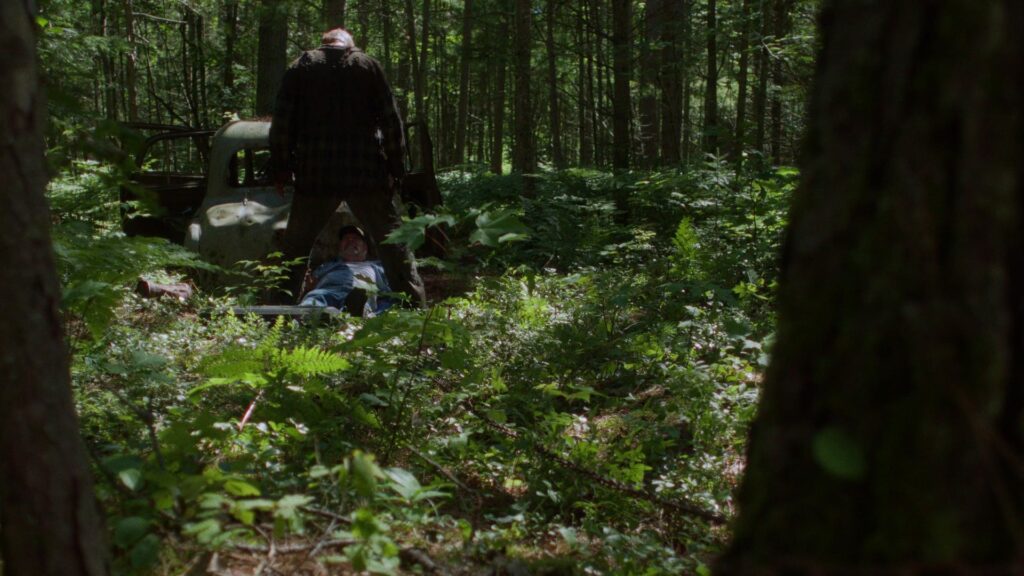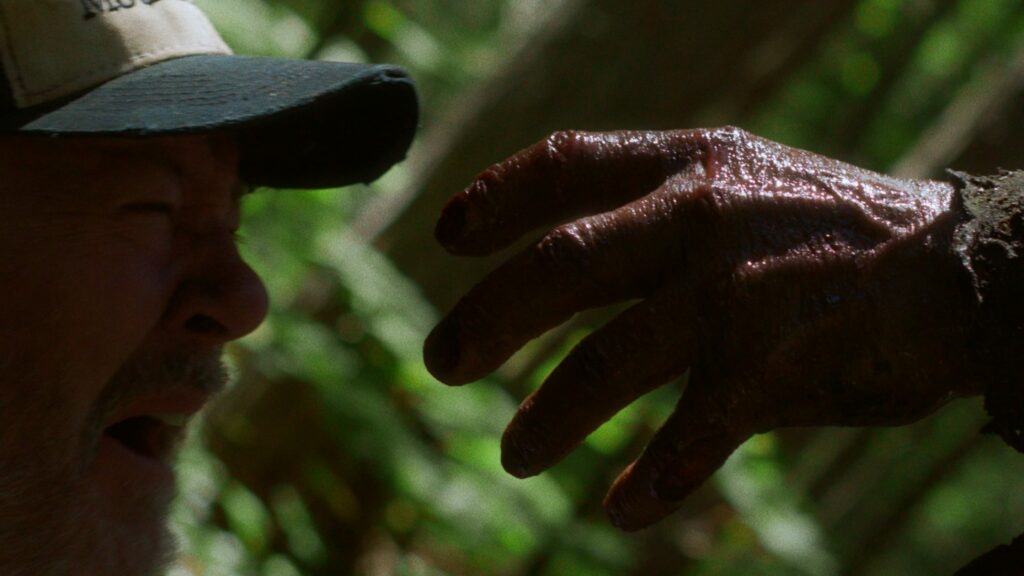Fridays of heaven
It’s a cheeky and intriguing pitch, I’ll give Chris Nash that much: What if a Friday the 13th movie was filmed from Jason Voorhees’ perspective in pseudo-slow cinema with pseudo-Malick nature photography, with almost nothing but tracking shots? What if the horny teens and their idiocy and even their jump scares were just on the periphery of the film, the main subject the plodding but precise killer?
What you get is a fascinating, half-baked experiment. That is the lens by which In a Violent Nature is most successful: Not as a slasher, not even as a movie, but as an intriguing execution for a goofy “what if” question. And I’ll give it credit for that. It isn’t “experimental cinema” by any stretch, but it does push the outer boundary of slashers, i.e. the most rigidly-structured and trope-bound subgenre of horror that is, to quote my Friday the 13th review, “so ripe for repetition, innovation, and eventually parody.” In a Violent Nature does this admirably: It inspires you to think a little bit more about the movies that inspired it. I was engaged and curious the whole time, and I spent a lot of the runtime imagining what this movie might look like if it were a “traditional” slasher (the answer is that it would be almost exactly a Friday the 13th film, circa entries 1-4 in that series). I don’t think In a Violent Nature has much in the way of metacommentary (hell, Friday the 13th Part 4 might be more introspective than this), but it’s at least fun to engage with as a thought exercise.

So it’s interesting but is it fun to watch? Is it good? Barely, on both counts. There’s enough irony baked into the premise such that it works best as a movie qua movie as a dry, formalist comedy for slasher-lovers. The tone is detached and subdued, but you’re still always thinking “I can’t believe I’m watching an arty-ass Friday the 13th; it’s so goofy,” which makes it funny even though it’s not at all a funny movie. The closest it gets to actual jokes are how ludicrous the kills are: some of the body horror is so outrageous that it circles back from gory to wacky. Nash wants us to laugh in astonishment at this film he’s created. (The gore effects, by the way, are sensational.)
But I still haven’t really answered the question. Does any of this make it a good movie? The presentation, at least, is quite nice. The gorgeous shots of woods in day and night, directly inspired by Terrence Malick according to Nash, are indeed rapturous. The sound design of nature is terrific, too, squishy and crunchy and rustling. (My one big beef with the sound design is that the characters’ voices are mixed too loud and clear; it’s not like what they’re saying matters too much, so I wish Nash had just let the voices be sounds wind-carried and distant to enhance the naturalism of wandering the woods and stumbling upon a distant crowd.)

Some of my film-geek friends have complained about the aspect ratio , which is a boxy 1.33:1. (Complaining about aspect ratios is truly one of the great film-geek pastimes.) I didn’t expect to agree with them, but I did: the movie would work better in a sprawling widescreen format so that we feel surrounded and all-consumed by the nature around us. Our pal Hunter at Kinemalogue suggests (then rejects) the idea that Nash wanted to invoke the VHS or early cable TV frame the way that many of us discovered B-rate horror movies like the ones that this is parodying. But everything else about the presentation and texture is rejecting the cheap presentation of those films, so I think the aspect ratio should have done the same.
If Friday the 13th is the genre and narrative reference, and Malick is the aesthetic reference (at least per Nash), the third key connection is Gus Van Sant. Even more than In a Violent Nature is a “slow cinema slasher” — since this really isn’t slow cinema at all — this film is “Elephant but about a slasher massacre instead of a school shooting.” In a Violent Nature adopts Elephant’s formal schema of long tracking shots where we follow the back of a character walking, as if playing a third-person perspective video game. In Elephant it was a way of toying with the humanity and narrative agency of various characters in a Columbine-esque shooting; here, it’s to investigate the monstrous brutality of a masked undead murderer, desaturating the story of its horror texture. The result of both films is to juxtapose the calm rhythms of its filmmaking with the horrifying story content in a way that unsettles us and shakes us out of our familiar emotional engagement with its material.

Where the film really flies off the rail is in the final act. You know what’s coming: the final girl chase. Instead of sticking to the gambit of the film leading up to it, Nash tries something radically different in these closing minutes. Parts of it work: we shift to a more subjective experience with more heightened sensory details: e.g., the nature foley ramps up to hyper-real volumes in a disorienting way, and the editing becomes suddenly elliptical. I was thrown off in a curious sort of way, for the first time unsure of what we would see next. But what actually happens on screen — or, more to the point, doesn’t happen on screen — belongs in a different movie. The first 70 minutes of In a Violent Nature are a slasher playing dress-up as a totally different genre as a formal experiment, depicting the tropes but with a different look-and-feel; the last 15, by contrast, are an anti-slasher, discarding the tropes as if this really were experimental cinema. (And, just to remind us we’re watching an arty horror film in the 2020s, it lets us know that this whole story is about trauma.)
So after all of that is done, I still haven’t answered the question. I still don’t know quite how to evaluate In a Violent Nature, whether to call it “good.” I guess so? I was fascinated enough by it, and have thought about it enough since watching, that I think I have to give it a soft passing grade even if it’s not ever scary or narratively interesting. I always enjoy a good high-concept slasher remix, though typically I mean that about the narrative (Happy Death Day, Freaky, Totally Killer) rather than the presentation and form. And since it’s essentially a Friday the 13th spinoff, a soft thumbs up feels right — that puts it above the mediocre and bad Fridays but a bit below the ones I actually like (2, 4, and 6).
Is It Good?
Good (5/8)
Dan is the founder and head critic of The Goods. Follow Dan on Letterboxd. Join the Discord for updates and discussion.


5 replies on “In a Violent Nature (2024)”
The whole movie’s sneering and mean-spirited in a way, though I’m not sure at precisely who–I still think it’s probably more “oh, you don’t like slasher movies, snob?” than it is slasher movies themselves, given Nash’s background (I mean, you can’t participate in Psycho Goreman, even below-the-marquee, and expect me to treat you like some kind of actual intellectual, at least not without another data point or two). But that attitude really goes off the rails in the last ten minutes, when he can’t figure out a way to be snide and mean-spirited about Elevated Horror without perpetrating an act of cruelty on his audience in the process.
Every time I’ve seen a person uncritically parrot the Terrence Malick thing I’ve had to bite my tongue so as not to call them names. Even leaving aside the extreme divergences in style (shot length, shot scales, the whole aspect ratio thing) and substance (Malick’s subject has been, since his comeback, principally his own spirituality), neither a Terry Malick movie nor Terry Malick characters would ever be as indifferent to nature as this actually feels like it is.
Citing Malick only makes sense if it’s the parody of art horror it presents itself as, basically just “Terrence Malick is the most famous working/living art filmmaker.” Man, can’t wait for The Last Planet or whatever it’s called now–ah, Way of the Wind. It’s enervating but also kind of exciting that it’s been in editing for FIVE FREAKING YEARS.
That said, “Fridays of Heaven” made me chuckle.
I did see your refutation of the Malick comparison. My take was that Nash is just going for that “leaves rustling in the wind at golden hour” cinematography and production that Malick is known for even if it’s not wholly representative of his oeuvre.
I decided just to take it at face value given that *gulp* I’ve never actually seen a Malick film from start to finish.
I don’t wanna be that guy, but I am that guy at least for the purposes of the “ya gotta watch some Malick” conversation. Then if it moves to pretty much literally anybody else I wanna talk about mouth breather genre movies instead. Maybe not Albert Serra. Y’know, Albert Serra, or at least The Death of Louis XIV, is a way better fake claim of influence for In a Violent Nature, but Louis XIV actually is slow cinema.
Though I happily admit Malick ain’t for everybody or even most. To wit, I also don’t particularly like his first two movies that made his initial pre-hiatus reputation. So I’d say the tack of going chronological through his filmography, as someone I know is wont to do, might be a mistake. First I saw was Thin Red Line, which is perhaps underrated as just a good war movie.
Malick schmalick, if they wanted to impress me they should have pretended this film was a sober documentary with Mr Werner Herzog as the host (On the other hand, if I had to chose between that and Mr Herzog playing Van Helsing in a DRACULA adaptation, I would absolutely pick the latter*).
*He’d absolutely nail the deadpan loopiness of the Good Professor and he’s enough of a vampire movie fan to have remade NOSFERATU, so he might even be prepared to do it!).